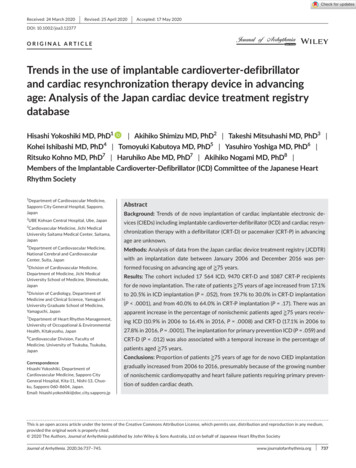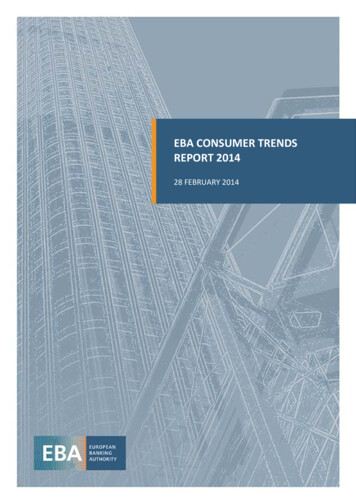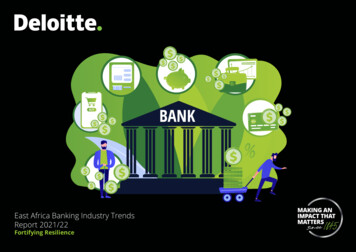
Transcription
Received: 24 March 2020 Revised: 25 April 2020 Accepted: 17 May 2020DOI: 10.1002/joa3.12377ORIGINAL ARTICLETrends in the use of implantable cardioverter-defibrillatorand cardiac resynchronization therapy device in advancingage: Analysis of the Japan cardiac device treatment registrydatabaseHisashi Yokoshiki MD, PhD1 Akihiko Shimizu MD, PhD2 Takeshi Mitsuhashi MD, PhD3 Kohei Ishibashi MD, PhD4 Tomoyuki Kabutoya MD, PhD5 Yasuhiro Yoshiga MD, PhD6 Ritsuko Kohno MD, PhD7 Haruhiko Abe MD, PhD7 Akihiko Nogami MD, PhD8 Members of the Implantable Cardioverter-Defibrillator (ICD) Committee of the Japanese HeartRhythm Society1Department of Cardiovascular Medicine,Sapporo City General Hospital, Sapporo,Japan2UBE Kohsan Central Hospital, Ube, Japan3Cardiovascular Medicine, Jichi MedicalUniversity Saitama Medical Center, Saitama,Japan4AbstractBackground: Trends of de novo implantation of cardiac implantable electronic devices (CIEDs) including implantable cardioverter-defibrillator (ICD) and cardiac resynchronization therapy with a defibrillator (CRT-D) or pacemaker (CRT-P) in advancingage are unknown.Department of Cardiovascular Medicine,National Cerebral and CardiovascularCenter, Suita, JapanMethods: Analysis of data from the Japan cardiac device treatment registry (JCDTR)5Division of Cardiovascular Medicine,Department of Medicine, Jichi MedicalUniversity School of Medicine, Shimotsuke,Japanformed focusing on advancing age of 75 years.6to 20.5% in ICD implantation (P .052), from 19.7% to 30.0% in CRT-D implantationDivision of Cardiology, Department ofMedicine and Clinical Science, YamaguchiUniversity Graduate School of Medicine,Yamaguchi, Japan7Department of Heart Rhythm Management,University of Occupational & EnvironmentalHealth, Kitakyushu, Japan8Cardiovascular Division, Faculty ofMedicine, University of Tsukuba, Tsukuba,JapanCorrespondenceHisashi Yokoshiki, Department ofCardiovascular Medicine, Sapporo CityGeneral Hospital, Kita-11, Nishi-13, Chuoku, Sapporo 060-8604, Japan.Email: hisashi.yokoshiki@doc.city.sapporo.jpwith an implantation date between January 2006 and December 2016 was perResults: The cohort included 17 564 ICD, 9470 CRT-D and 1087 CRT-P recipientsfor de novo implantation. The rate of patients 75 years of age increased from 17.1%(P .0001), and from 40.0% to 64.0% in CRT-P implantation (P .17). There was anapparent increase in the percentage of nonischemic patients aged 75 years receiving ICD (10.9% in 2006 to 16.4% in 2016, P .0008) and CRT-D (17.1% in 2006 to27.8% in 2016, P .0001). The implantation for primary prevention ICD (P .059) andCRT-D (P .012) was also associated with a temporal increase in the percentage ofpatients aged 75 years.Conclusions: Proportion of patients 75 years of age for de novo CIED implantationgradually increased from 2006 to 2016, presumably because of the growing numberof nonischemic cardiomyopathy and heart failure patients requiring primary prevention of sudden cardiac death.This is an open access article under the terms of the Creative Commons Attribution License, which permits use, distribution and reproduction in any medium,provided the original work is properly cited. 2020 The Authors. Journal of Arrhythmia published by John Wiley & Sons Australia, Ltd on behalf of Japanese Heart Rhythm SocietyJournal of Arrhythmia. 2020;36:737–745. www.journalofarrhythmia.org 737
738 YOKOSHIKI et al.KEYWORDSadvancing age, cardiac resynchronization therapy with a defibrillator (CRT-D), cardiacresynchronization therapy with a pacemaker (CRT-P), implantable cardioverter-defibrillator(ICD), primary preventionde novo implantation of CIEDs including ICD/CRT-D/CRT-P.10-12 A new1 I NTRO D U C TI O Nsystem, called New JCDTR, started on January 2019, in which data of patients at the implantation date after January 2018 are encouraged to reg-Implantable cardioverter-defibrillator (ICD) therapy has been provedister (https://membn ew.jhrs.or.jp/newjc dtr/ accessed on March 1, 2020).to be effective for primary prevention of sudden cardiac death in pa-The protocol for this research project has been approved by a suitablytients with symptomatic heart failure with reduced ejection fractionconstituted Ethics Committee of each institution and it conforms to the(HFrEF),1-3 and its use is prevailing as one of the standard therapiesprovisions of the Declaration of Helsinki. This study analyzed the data ofin combination with guideline-directed medical therapy. Age of pa-implantation date from 2006 to 2016 according to age of patients.tients enrolled in randomized controlled trials was 65 10 years oldThe Japan Arrhythmia Device Industry Association (JADIA) re-(means SD) in the Multicenter Automatic Defibrillator Implantationports the annual number of de novo implantations of ICD and CRT-DTrial II (MADIT II),3 60 years old (median) in the Sudden Cardiacfrom 2009 and that of CRT-P from 2015 (https://www.jadia.or.jp;1Death in Heart Failure Trial (SCD-HeFT) and around 67 yearsFigure 1A). This study also evaluated the ratio of our registration toold (median) in the Comparison of Medical Therapy, Pacing andthat reported in the JADIA (JCDTR/JADIA ratio).Defibrillation in Heart Failure (COMPANION) study. 2 On the otherhand, the Amiodarone Trialists MetAnalysis (ATMA) investigatorsdemonstrated that sudden death to all-cause death ratio decreased2.2 Statistical analysiswith age, which was 51% in those age 50 years and 26% in thoseafter age 80 years.4 Moreover, in nonischemic patients with HFrEF,All data are expressed as mean SD. Simple between-group analysisthe association between reduced all-cause mortality and ICD im-was conducted using Student's t test. Multiple comparisons were as-plantation became no significant with increasing age, and an optimalsessed by ANOVA with the post hoc analysis using a Bonferroni testage cutoff for ICD implantation was present at 70 years.5when necessary. Categorical variables were compared using the Chi-The United States (US) trends demonstrated that CRT-P use de-square test. Differences with P .05 were considered significant.creased progressively from 2002 (28.8% of all CRTs) to 2010 (15.2%Statview version 5.0 for Windows (SAS Institute Inc.) or R softwareof all CRTs) and that the percentage of CRTs (CRT-D and CRT-P) im-ver.3.2.3 (https://www.r-proje c t.org/) was used for all statisticalplanted in patients aged 85 years increased from 4.9% in 2003 to 8%analyses.in 2010.6 In CRT recipients without a prior history of sustained ventricular arrhythmias, advancing age was significantly associated withthe choice of CRT-P over CRT-D in Japan, resulting that the mean ageof those receiving CRT-P was 75 years old.7 This clinical practice couldbe reasonable because a defibrillator backup had subtle or no survival3 R E S U LT S3.1 Study cohortsbenefit in symptomatic heart failure patients requiring a CRT devicein randomized controlled studies.2,8,9 However, Japanese trends in theThe JCDTR database constituted data of 28 121 patients who under-age-stratified use of ICD and CRT device have not been evaluated.went de novo implantations of ICD, CRT-D or CRT-P from JanuaryThis study was aimed at examining temporal trends of cardiac2006 to December 2016 (extracted on 29 September 2018). To beimplantable electronic devices (CIEDs), including ICD/CRT-D/CRT-more specific, 17 564 ICD recipients, 9470 CRT-D recipients and 1087P, implantation by analyzing the Japan Cardiac Device TreatmentCRT-P recipients were included for the evaluation (Table 1). With re-Registry (JCDTR) database and to explore the hypothesis that theregard to age, gender, left ventricular ejection fraction (LVEF) and Newis an increasing number of CIEDs implanted in older patients agedYork Heart Association (NYHA) class, there were significant differ- 75 years over a decade in the recent aging society in Japan.ences among the three groups. The mean age of CRT-P recipients was74.3 years old, which was higher than 60.8 years old of ICD recipients2 M E TH O DS2.1 Study population(P .0001) and 66.9 years old of CRT-D recipients (P .0001). Therate of ischemic heart disease was 36.4% in ICD recipients, which washighest among the three groups (P .0001). The indication for defibrillation therapy was primary prevention in 66.7% of CRT-D recipientsand in 25.6% of ICD recipients (P .0001; Table 1). The rate of CRTThe JCDTR was established in 2006 by the Japanese Heart Rhythm(CRT-D and CRT-P) recipients without a prior history of sustained ven-Society (JHRS) for a survey of actual conditions in patients undergoingtricular arrhythmias (ie, primary prevention of sudden cardiac death)
YOKOSHIKI et al.739F I G U R E 1 Japanese trends in de novoCIEDs implantation. The number of newimplantations of ICD (gray bar)/CRT-D(blue bar)/CRT-P (orange bar) in each yearis shown based on the data from (A) JapanArrhythmia Device Industry Association(JADIA) and (B) Japan cardiac devicetreatment registry (JCDTR). Percentageof registration of the JCDTR to that ofJADIA (JCDTR/JADIA ratio) is given as linegraphs (B).was 69.8% (not shown in Table 1). The number of registrations wasin patients aged 75 years and those aged 85 years was increasedmaximum in 2011 which included 2007 patients with ICD, 1226 pa-from 20% and 1.8% in 2006 to 36.7% and 5.8% in 2016, respectivelytients with CRT-D and 124 patients with CRT-P (Figure 1B).(P .0001 for the two age groups).Proportion of patients aged 75 years and those 85 yearswas 19.3% and 1.7% in all ICD implantations, 27.0% and 2.0% in allCRT-D implantations, and 59.0% and 13.0% in all CRT-P implanta-3.2.2 Etiology: ischemic vs nonischemictions (Figure 2). The distribution of advancing age for these CIEDsimplantation was significantly different (P .0001).With regard to the etiology of heart diseases, there was a significantincrease in the percentage of nonischemic patients 75 years of age3.2 Age-stratified ICD/CRT-D/CRT-Pimplant trends3.2.1 Overallwith ICD (10.9% in 2006 to 16.4% in 2016, P .0008) and CRT-D(17.1% in 2006 to 27.8% in 2016, P .0001) implantations. There wasan increasing trend in nonischemic CRT-P recipients 75 years of age,but with no statistical significance (25% in 2006 to 61.7% in 2016,P .22). The rate of ischemic patients 75 years of age changed withno statistical significance in ICD (28.0% in 2006 to 27.6% in 2016,In 2006, the percentage of ICD recipients and CRT-P recipi-P .87), CRT-D (26.3% in 2006 to 35.3% in 2016, P .64) and CRT-Pents 75 years of age was 17.1% and 40%. The rate increased to(100% in 2006 to 70.5% in 2016) implantations (Figure 4).20.5% for ICD recipients and 64.0% for CRT-P recipients in 2016,with a marginal significance (P .052 for ICD, P .17 for CRT-P;Figure 3A,C). There was a significant increase in the percentage ofCRT-D recipients 75 years of age from 19.7% in 2006 to 30.0% in3.2.3 Indication: primary prevention vssecondary prevention2016 (P .0001). The percentage of CRT-D recipients 85 years ofage was 1.8% in 2006, and it increased to 3.5% in 2016 (P .0018;The percentage of secondary prevention ICD recipients and CRT-DFigure 3B). The percentage of all CRTs (CRT-D and CRT-P) implantedrecipients 75 years of age was 18.5% and 21.5% in 2006, and
740YOKOSHIKI et al.PvalueICDCRT-DCRT-PNumber of patients1756494701087Age (y)60.8 15.466.9 11.274.3 11.1 .0001Male13745 (78.2)7172 (75.7)671 (61.7) .00012959 (31.2)280 (25.8)Underlying heart diseaseIschemic6394 (36.4) .0001Nonischemic111170 (63.6)6511 (68.8)807 (74.2)Primarypreventiona4502 (25.6)6317 (66.7)1048 (96.4)50.0 17.127.6 9.232.6 11.3I9822 (55.9)344 (3.6)35 (3.2)II5742 (32.7)2370 (25.0)259 (23.8)III1735 (9.9)5648 (59.7)705 (64.9)IV265 (1.5)1108 (11.7)88 (8.1)LVEF (%)TA B L E 1 Characteristics of patientsundergoing CIEDs implantation, stratifiedby device type .0001NYHA class .0001Note: Values are means SD, or number (%).Abbreviation: ICD, implantable cardioverter-defibrillator; LVEF, left ventricular ejection fraction;NYHA, New York Heart Association.aPatients without a prior history of sustained ventricular arrhythmias are defined as primaryprevention.stat.go.jp/data/jinsu i/2016np). In accordance with this demographicchange, this study demonstrated, with analyses of the JCDTR database, there has been a significant increase in the rate of de novoCIEDs implanted in patients with advancing age (ie, 75 years).Patients with nonischemic cardiomyopathy (but not ischemic cardiomyopathy) undergoing primary prevention CRT-D and ICD significantly contributed to the increase in the implantation of the aged( 75 years) population.An observation that the percentage of all CRTs (CRT-D andCRT-P) implanted in patients aged 85 years increased from 1.8%F I G U R E 2 Proportion of different age groups in CIEDimplantation. Groups of patients aged 75 y (blue bar), aged75-84 y (orange bar) and aged 85 y (gray bar) are shown as thepercentages for ICD, CRT-D and CRT-P implantation. The agedistribution was significantly different among CIED implantations(P .0001).in 2006 to 5.8% in 2016 was similar to the situation in the US, 6but the proportion was less than that reported in the US (6.7%in 2006, 8.0% in 2010). 6 The rate of primary prevention CRT-Dimplantation was 66.7% in this study (Table 1), which was lowerthan that of cohort studies in the US and Europe (72.4% in theUS13 and 87% in Europe14). If symptomatic heart failure patientsrequiring a CRT device increase further and we opt to implant the20.5% and 22.0% in 2016. In contrast, there was a significant in-device for primary prevention more frequently, the rate of CRTcrease in the percentage of primary prevention CRT-D recipientsimplantation in advancing age may become the same level as in 75 years of age (18.8% in 2006 to 33.6% in 2016, P .012). Therethe US.was an increasing trend in the percentage of primary prevention ICDIn contrast to the higher prevalence of ischemic cardiomyopa-recipients 75 years of age (13.1% in 2006 to 20.4% in 2016 for ICD,thy in the United States,15 about 70% of heart failure patients haveP .059; Figure 5).nonischemic etiology in Japan (Table 1). In a subanalysis of theCardiac Resynchronization – Heart Failure (CARE-HF), patients with4 D I S CU S S I O Nischemic cardiomyopathy showed a higher incidence of the primaryoutcome and worse prognosis, as compared to nonischemic cardiomyopathy.16 Therefore, the rate of ischemic patients of advancingThe population of Japan decreased from 127.9 million in 2006 toage who have an indication for CRT-D may not be increasing to126.9 million in 2016, whereas the percentage of aged ( 75 years)the same extent of nonischemic patients. In addition, there couldpeople increased from 9.5% in 2006 to 13.3% in 2016 (https://www.be more comorbidities in ischemic patients, as they are generally
YOKOSHIKI et al.741F I G U R E 3 Age-stratified CIEDsimplant trends. Implantation trends inthe patient groups, aged 75 y (blue bar),aged 75-84 y (orange bar) and aged 85 y(gray bar), and the percentage of patientsaged 75 y (yellow line) is given for ICD(A), CRT-D (B) and CRT-P (C) implantation.The percentage of patients aged 75 y increased significantly in CRT-Dimplantation (P .0001). The increase wasmarginal in ICD implantation (P .052)and CRT-P implantation (P .17).relating to atherosclerosis in the whole body. A subanalysis of thecompare the effects of CRT-D and CRT-P on morbidity and mortalityMADIT II demonstrated reduced or lack of ICD benefit in patientsin such heart failure patients are scarce. 2,8,917This evidence may have precludedSeveral observational studies could not identify symptomaticus from implanting CRT-D and ICD in ischemic patients 75 yearswith the highest comorbidities.heart failure patients who benefit more from CTR-D than CRT-with high comorbidities.P, as there were significant demographic and morbid differencesBased on the analysis of the JCDTR, determinants for selectingbetween the two patient groups.14,18,19 Despite this, the supe-primary prevention CRT-D over CRT-P in patients with symptomaticriority of CRT-D to CRT-P was reported in HFrEF patients withHFrEF were younger age, male, reduced LVEF, a history of nonsus-ischemic cardiomyopathy, 20-23 those with nonischemic cardiomy-7tained ventricular tachycardia (NSVT). As expected, there was aopathy having left ventricular midwall fibrosis24 and those withremarkable disparity of age groups in ICD/CRT-D/CRT-P implantedthe Goldenberg (MADIT) risk scores 0-2. 25 More recently, CRT-Dpatients, with the highest percentage of advancing age in CRT-P re-was not associated with prolonged survival especially in nonisch-cipients (Figure 2). However, we do not have an appropriate answeremic cardiomyopathy and no previous history of ventricular ar-regarding choice of CRT devices, ie, CRT-D or CRT-P, for HFrEF pa-rhythmias, as compared to CRT-P. 26,27 Besides, in systolic hearttients with a QRS duration 130 m/s and left bundle branch blockfailure patients aged 75 years28 or 80 years, 29 there was no(LBBB) QRS morphology without prior sustained ventricular ar-significant difference in the risk of mortality between CRT-D andrhythmias. This is because randomized controlled trials that directlyCRT-P groups after adjusting for baseline differences. Since (a)
742 YOKOSHIKI et al.F I G U R E 4 Age-stratified CIED implant trends in ischemic and nonischemic etiologies. Implantation trends in three patient groups, aged 75 y (blue bar), aged 75-84 y (orange bar) and aged 85 y (gray bar), and the percentage of patients aged 75 y (yellow line) are given forischemic (left) and nonischemic (right) patients with ICD (A), CRT-D (B) and CRT-P (C) implantation. The percentage of patients aged 75 yincreased significantly in nonischemic ICD (right panel in A, P .0008) and CRT-D (right panel in B, P .0001) implantation. The increasewas not significant in nonischemic CRT-P implantation (right panel in C, P .21). There was no statistical significant increase in age-stratifiedimplant trends for ischemic ICD, CRT-D, and CRT-P implantation (left panels in A, B and C).CRT-Ds are larger and more expensive than CRT-Ps and (b) theversion of JCDTR (New JCDTR) is now operative (https://membn predominant etiology of heart failure is nonischemic in Japan, weew.jhrs.or.jp/newjc dtr/) and data of the implantation and follow-upneed to perform future research focusing on not only major car-in ICD/CRT-D/CRT-P implanted patients after January 2018 are pro-diac events and mortality but also quality of life and cost effec-spectively enrolled. We hope the New JCDTR will be able to providetiveness in symptomatic heart failure patients undergoing CRT-Dfirm and further evidence of Japanese patients.vs CRT-P especially in advancing age of 75 years.4.1 Study limitations5 CO N C LU S I O N SThere has been an apparent increase in the percentage of de novoThere are several limitations to be considered in this study. First,ICD/CRT-D/CRT-P implanted in patients aged 75 years in Japan.clinical outcomes are not shown in this study, but we reported sev-The implantation for primary prevention ICD and CRT-D as well as ineral outcomes in other studies.19,30 Second, the rate of registrationnonischemic cardiomyopathy contributed to the temporal increasewith the JCDTR is decreasing as evident from the data of JADIA. Forin CIED implantation in advancing age.example, ratio of registration of the JCDTR to that of JADIA (JCDTR/JADIA ratio) was 57.0% for ICD and 49.3% for CRT-D in 2011, but itAC K N OW L E D G E M E N T Sdeclined gradually. In 2016, the JCDTR/JADIA ratio was 33.6% forWe thank all the members of the JHRS who registered data in theICD, 32.6% for CRT-D and 21.1% for CRT-P (Figure 1B). The secondJCDTR on a voluntary basis. As of 20 March 2020, 393 facilities in
YOKOSHIKI et al.743F I G U R E 5 Age-stratified CIED implant trends in primary prevention and secondary prevention for sudden cardiac death. Implantationtrends in three patient groups, aged 75 y (blue bar), aged 75-84 y (orange bar) and aged 85 y (gray bar), and the percentage of patientsaged 75 y (yellow line) are given for primary prevention (left) and secondary prevention (right) ICD (A) and CRT-D (B) implantation. Thepercentage of patients aged 75 y increased significantly only in primary prevention CRT-D implantation (left panel in B, P .012). Theincrease in the percentage of patients aged 75 y was marginal in primary prevention ICD implantation (left panel in A, P .059).Japan had enrolled at least one patient. The list of the facilities thatNippon Medical University, Nippon Medical School Chiba Hokusouenrolled more than 100 patients (114 facilities in alphabetical order)Hospital, Odawara Municipal Hospital, Okayama University, Okinawais given below.Prefectural Chubu Hospital, Osaka City General Hospital, Osaka CityAkita Medical Center, Anjo Kosei Hospital, Bellland GeneralUniversity, Osaka Medical College, Osaka Police Hospital, Osaka RedHospital, Dokkyo Medical University, Edogawa Hospital, FujitaCross Hospital, Osaka University, Osaki Hospital Tokyo Heart Center,Health University, Fukushima Medical University, Gifu PrefecturalSaiseikai Central Hospital, Saiseikai Fukuoka General Hospital, SaiseikaiGeneral Medical Center, Gifu University, Gunma University, HirosakiKumamoto Hospital, Saiseikai Shimonoseki General Hospital, SaiseikaiUniversity, Hokkaido University Hospital, Hokko Memorial Hospital,Yokohamashi Tobu Hospital, Saitama Red Cross Hospital, SakakibaraHyogo College of Medicine, IMS Katsushika Heart Center, IshinomakiMemorial Hospital, Saku Central Hospital, Sakurabashi WatanabeRed Cross Hospital, Itabashi Chuo Medical Center, JA ToyamaHospital, Seirei Hamamatsu General Hospital, Sendai Kosei Hospital,Kouseiren Takaoka Hospital, Japanese Red Cross Society Kyoto DainiShiga University of Medical Science, Shinshu University, Shizuoka mu-Hospital, Japanese Red Cross Wakayama Medical Center, JCHOnicipal Hospital, Showa General Hospital, Southern Tohoku GeneralHokkaido Hospital, JCHO Kyushu Hospital, Jichi Medical University,Hospital, St. Luke's International Hospital, St. Marianna UniversityJuntendo University, Juntendo University Urayasu Hospital, KakogawaSchool of Medicine, Takeda Hospital, Tenri Hospital, The UniversityEast City Hospital, Kameda Medical Center, Kanazawa Medicalof Tokyo, Toho University, Tokai University, Tokyo Medical University,University, Kansai Rosai Hospital, Keio University, Kitano Hospital,Tokyo Metropolitan Bokutoh Hospital, Tokyo Metropolitan HirooKitasato University, Kochi Health Science Center, Kokura MemorialHospital, Tokyo Metropolitan Tama Medical Center, Tokyo Women'sHospital, Komaki City Hospital, Kumamoto Red Cross Hospital,Medical University, Tottori University, Toyama Prefectural CentralKumamoto University, Kurashiki Chuo Hospital, Kyorin University,Hospital, Toyama University, Toyohashi Heart Center, Tsuchiura KyodoKyoto Prefectural University of Medicine, Kyoto-Katsura Hospital,General Hospital, Tsukuba Medical Center Hospital, University of Fukui,Maebashi Red Cross Hospital, Matsudo City Hospital, Matsue RedUniversity of Miyazaki, University of Occupational and EnvironmentalCross Hospital, Matsumoto Kyoritsu Hospital, Mie University, MitoHealth, University of Tsukuba, Urasoe General Hospital, YamagataSaiseikai General Hospital, Nagasaki University, Nagoya TokushukaiPrefectural Central Hospital, Yamagata University, YamaguchiGeneral Hospital, Nagoya University, Nara Medical University,University, Yamanashi Prefectural Central Hospital, Yokohama CityNational Hospital Organization Kagoshima Medical Center, NationalUniversity Hospital, Yokohama Rosai Hospital.Hospital Organization Kanazawa Medical Center, National HospitalOrganization Kyushu Medical Center, National Hospital OrganizationC O N FL I C T S O F I N T E R E S TShizuoka Medical Center, Nihon University, Niigata University,The authors declare no conflict of interest related to this study.
744 YOKOSHIKI et al.ORCIDHisashi RENCES1. Bardy GH, Lee KL, Mark DB, Poole JE, Packer DL, Boineau R,et al. Amiodarone or an implantable cardioverter-defibrillator forcongestive heart failure. N Engl J Med. 2005;352(3):225–37. Epub2005/01/22.2. Bristow MR, Saxon LA, Boehmer J, Krueger S, Kass DA, De MarcoT, et al. Cardiac-resynchronization therapy with or without an implantable defibrillator in advanced chronic heart failure. N Engl JMed. 2004;350(21):2140–50. Epub 2004/05/21.3. Moss AJ, Zareba W, Hall WJ, Klein H, Wilber DJ, Cannom DS,et al. Prophylactic implantation of a defibrillator in patients withmyocardial infarction and reduced ejection fraction. N Engl J Med.2002;346(12):877–83. Epub 2002/03/22.4. Krahn AD, Connolly SJ, Roberts RS, Gent M. Diminishing proportional risk of sudden death with advancing age: implications for prevention of sudden death. Am Heart J. 2004;147(5):837–40. Epub2004/05/08.5. Elming MB, Nielsen JC, Haarbo J, Videbæk L, Korup E, SignorovitchJ, et al. Age and outcomes of primary prevention implantablecardioverter-defibrillators in patients with nonischemic systolic heart failure. Circulation. 2017;136(19):1772–80. Epub2017/09/08.6. Sridhar AR, Yarlagadda V, Parasa S, Reddy YM, Patel D, LakkireddyD, et al. Cardiac resynchronization therapy. Circulation:Arrhythmia and Electrophysiology. 2016;9(3):e003108. Epub2016/02/28.7. Yokoshiki H, Shimizu A, Mitsuhashi T, Furushima H, SekiguchiY, Manaka T, et al. Trends and determinant factors in the use ofcardiac resynchronization therapy devices in Japan: analysis ofthe Japan cardiac device treatment registry database. J Arrhythm.2016;32(6):486–90. Epub 2016/12/07.8. Gold MR, Daubert J-C, Abraham WT, Hassager C, Dinerman JL,Hudnall JH, et al. Implantable defibrillators improve survival inpatients with mildly symptomatic heart failure receiving cardiacresynchronization therapy: analysis of the long-term follow-up ofremodeling in systolic left ventricular dysfunction (REVERSE). CircArrhythmia Elec. 2013;6(6):1163–8. Epub 2013/10/16.9. Schuchert A, Muto C, Maounis T, Frank R, Boulogne E, Polauck A,et al. Lead complications, device infections, and clinical outcomes inthe first year after implantation of cardiac resynchronization therapy-defibrillator and cardiac resynchronization therapy-pacemaker.Europace. 2013;15(1):71–6. Epub 2012/08/29.10. Shimizu A, Mihashi T, Furushima H, Sekiguchi Y, Manaka T, NishiiN, et al. Current status of cardiac resynchronization therapy withdefibrillators and factors influencing its prognosis in Japan. JArrhythmia. 2013;29:168–74.11. Shimizu A, Nitta T, Kurita T, Imai K, Kimura T, Kobayashi Y, et al.Current status of implantable defibrillator devices in patients withleft ventricular dysfunction - The first report from the online registry database. J Arrhythmia. 2008;24:133–40.12. Shimizu A, Nitta T, Kurita T, Imai K, Kobayashi Y, Soejima K, et al.Actual conditions of implantable defibrillator therapy over 5 yearsin Japan. J Arrhythmia. 2012;28:263–72.13. Lindvall C, Chatterjee NA, Chang Y, Chernack B, Jackson VA, SinghJP, et al. National trends in the use of cardiac resynchronizationtherapy with or without implantable cardioverter-defibrillator.Circulation. 2016;133(3):273–81. Epub 2015/12/05.14. Marijon E, Leclercq C, Narayanan K, Boveda S, Klug D, LacazeGadonneix J, et al. Causes-of-death analysis of patients with cardiacresynchronization therapy: an analysis of the CeRtiTuDe cohortstudy. Eur Heart J. 2015;36(41):2767–76. Epub 2015/09/04.15. Yokoshiki H, Mitsuyama H, Watanabe M, Mitsuhashi T, Shimizu A.Cardiac resynchronization therapy in ischemic and non-ischemiccardiomyopathy. J Arrhythm. 2017;33(5):410–6. Epub 2017/10/13.16. Wikstrom G, Blomstrom-Lundqvist C, Andren B, LonnerholmS, Blomstrom P, Freemantle N, et al. The effects of aetiology onoutcome in patients treated with cardiac resynchronization therapy in the CARE-HF trial. Eur Heart J. 2009;30(7):782–8. Epub2009/01/27.17. Goldenberg I, Vyas AK, Hall WJ, Moss AJ, Wang H, He H, et al. Riskstratification for primary implantation of a cardioverter-defibrillator in patients with ischemic left ventricular dysfunction. J Am CollCardiol. 2008;51(3):288–96. Epub 2008/01/22.18. Reitan C, Chaudhry U, Bakos Z, Brandt J, Wang L, Platonov PG,et al. Long-Term Results of Cardiac Resynchronization Therapy: AComparison between CRT-Pacemakers versus Primary ProphylacticCRT-Defibrillators. Pacing Clin Electrophysiol. 2015;38(6):758–67.Epub 2015/03/20.19. Yokoshiki H, Shimizu A, Mitsuhashi T, Furushima H, Sekiguchi Y,Manaka T, et al. Survival and heart failure hospitalization in patientswith cardiac resynchronization therapy with or without a defibrillator for primary prevention in Japan—Analysis of the Japan cardiacdevice treatment registry database. Circ J. 2017. Epub 2017/06/20.20. Barra S, Boveda S, Providencia R, Sadoul N, Duehmke R, ReitanC, et al. Adding defibrillation therapy to cardiac resynchronization on the basis of the myocardial substrate. J Am Coll Cardiol.2017;69(13):1669–78. Epub 2017/04/01.21. Kutyifa V, Geller L, Bogyi P, Zima E, Aktas MK, Ozcan EE, et al.Effect of cardiac resynchronization therapy with implantable cardioverter defibrillator versus cardiac resynchronization therapywith pacemaker on mortality in heart failure patients: resultsof a high-volume, single-centre experience. Eur J Heart Fail.2014;16(12):1323–30. Epub 2014/11/08.22. Leyva F, Zegard A, Umar F, Taylor RJ, Acquaye E, Gubran C, et al.Long-term clinical outcomes of cardiac resynchronization therapywith or without defibrillation: impact of the aetiology of cardiomyopathy. Europace. 2018;20(11):1804–12. Epub 2018/04/27.23. Witt CT, Kronborg MB, Nohr EA, Mortensen PT, Gerdes C, JensenHK, et al. Adding the implantable cardioverter-defibrillator tocardiac resynchronization therapy is associated with improvedlong-term survival in ischaemic, but not in non-isc
Implantable cardioverter-defibrillator (ICD) therapy has been proved . with ICD (10.9% in 2006 to 16.4% in 2016, P .0008) and CRT-D . University of Miyazaki, University of Occupational and Environmental Health, University of Tsukuba, Urasoe General Hospital, Yamagata











